Flammable & Combustible
Liquids - Hazards
Flammable & Combustible Liquids Hazards
Do you know the answers to these important questions?
Or click on any question to unveil its answer
What are flammable and combustible liquids?
Flammable and combustible liquids are liquids that can burn. They are classified, or grouped, as either flammable or combustible by their flashpoints. Generally speaking, flammable liquids will ignite (catch on fire) and burn easily at normal working temperatures. Combustible liquids have the ability to burn at temperatures that are usually above working temperatures.
There are several specific technical criteria and test methods for identifying flammable and combustible liquids. Under the Workplace Hazardous Materials Information System (WHMIS), flammable liquids have a flashpoint below 37.8°C (100°F). Combustible liquids have a flashpoint at or above 37.8°C (100°F) and below 93.3°C (200°F).
Flammable and combustible liquids are present in almost every workplace. Fuels and many common products like solvents, thinners, cleaners, adhesives, paints, waxes and polishes may be flammable or combustible liquids. Everyone who works with these liquids must be aware of their hazards and how to work safely with them.
What is a flashpoint?
The flashpoint of a liquid is the lowest temperature at which the liquid gives off enough vapour to be ignited (start burning) at the surface of the liquid. Sometimes more than one flashpoint is reported for a chemical. Since testing methods and purity of the liquid tested may vary, flashpoints are intended to be used as guides only, not as fine lines between safe and unsafe.
Does the liquid itself burn?
Flammable and combustible liquids themselves do not burn. It is the mixture of their vapours and air that burns. Gasoline, with a flashpoint of -40°C (-40°F), is a flammable liquid. Even at temperatures as low as -40°C (-40°F), it gives off enough vapour to form a burnable mixture in air. Phenol is a combustible liquid. It has a flashpoint of 79°C (175°F), so it must be heated above that temperature before it can be ignited in air.
What are flammable or explosive limits?
A material's flammable or explosive limits also relate to its fire and explosion hazards. These limits give the range between the lowest and highest concentrations of vapour in air that will burn or explode.
The lower flammable limit or lower explosive limit (LFL or LEL) of gasoline is 1.4 percent; the upper flammable limit or upper explosive limit (UFL or UEL) is 7.6 percent. This means that gasoline can be ignited when it is in the air at levels between 1.4 and 7.6 percent. A concentration of gasoline vapour in air below 1.4 percent is too "lean" to burn. Gasoline vapour levels above 7.6 percent are too "rich" to burn. Flammable limits, like flashpoints however, are intended as guides not as fine lines between safe and unsafe.
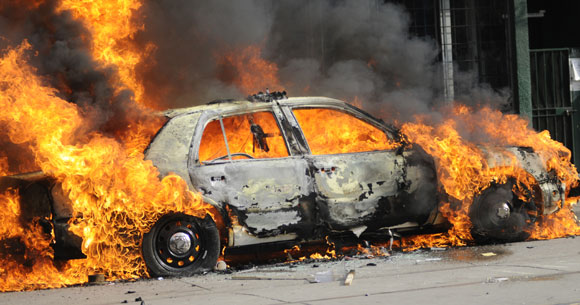
What is an Autoignition Temperature?
A material's autoignition or ignition temperature is the temperature at which a material self-ignites without any obvious sources of ignition, such as a spark or flame.
Most common flammable and combustible liquids have autoignition temperatures in the range of 300°C (572°F) to 550°C (1022°F). Some have very low autoignition temperatures. For example, ethyl ether has an autoignition temperature of 160°C (356°F) and its vapours have been ignited by hot steam pipes. Serious accidents have resulted when solvent-evaporating ovens were heated to temperatures above the autoignition temperature of the solvents used. Autoignition temperatures, however, are intended as guides, not as fine lines between safe and unsafe. Use all precautions necessary.
How can flammable and combustible liquids be a fire or explosion hazard?
At normal room temperatures, flammable liquids can give off enough vapour to form burnable mixtures with air. As a result, they can be a serious fire hazard. Flammable liquid fires burn very fast. They also give off a lot of heat and often clouds of thick, black, toxic smoke.
Combustible liquids at temperatures above their flashpoint also release enough vapour to form burnable mixtures with air. Hot combustible liquids can be as serious a fire hazard as flammable liquids.
Spray mists of flammable and combustible liquids in air may burn at any temperature if an ignition source is present. The vapours of flammable and combustible liquids are usually invisible. They can be hard to detect unless special instruments are used.
Most flammable and combustible liquids flow easily. A small spill can cover a large area of workbench or floor. Burning liquids can flow under doors, down stairs and even into neighbouring buildings, spreading fire widely. Materials like wood, cardboard and cloth can easily absorb flammable and combustible liquids. Even after a spill has been cleaned up, a dangerous amount of liquid could still remain in surrounding materials or clothing, giving off hazardous vapours.
What is the danger of flashback?
Vapours can flow from open liquid containers. The vapours from nearly all flammable and combustible liquids are heavier than air. If ventilation is inadequate, these vapours can settle and collect in low areas like sumps, sewers, pits, trenches and basements. The vapour trail can spread far from the liquid. If this vapour trail contacts an ignition source, the fire produced can flash back (or travel back) to the liquid. Flashback and fire can happen even if the liquid giving off the vapour and the ignition source are hundreds of feet or several floors apart.
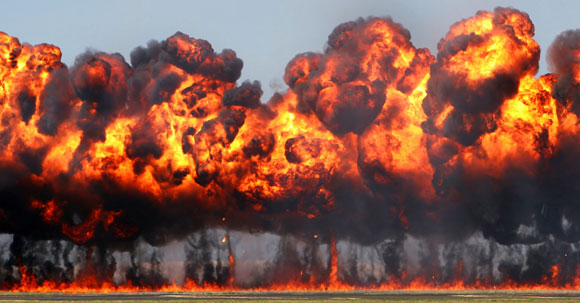
Can flammable or combustible liquids be hazardous to my body?
The most obvious harm would be the danger of a fire or explosion. After the immediate danger of a fire, there are sometimes other properties of these liquids that may be hazardous to the body. Flammable and combustible liquids can also cause health problems depending on the specific material and route of exposure (breathing the vapour/mist, eye or skin contact, or swallowing). Some flammable and combustible liquids are corrosive. Many undergo dangerous chemical reactions if they contact incompatible chemicals such as oxidizing materials, or if they are stored improperly.
The Material Safety Data Sheet and the supplier's labels on the containers should tell you about all the hazards for the flammable and combustible liquids that you work with.
An example is 2-propanol (also known as: dimethylcarbinol, isopropanol, or isopropyl alcohol). It is a colourless liquid with a sharp odour like rubbing alcohol or resembling that of a mixture of ethanol and acetone. It is flammable liquid and vapour. Vapour is heavier than air and may spread long distances. Distant ignition and flashback are possible. It is also considered to be a mild central nervous system depressant. High vapour may cause headache, nausea, dizziness, drowsiness, incoordination, and confusion. It may also be irritating to the respiratory tract or eyes.
What topics are covered in this question and answer document?
This document describes general safe work practices to use where flammable and combustible liquids are used or stored. The scope of this document can be seen by checking the list of questions above. The document Flammable and Combustible Liquids and their Hazards describes the hazards of these liquids more fully. Another documentdeals with safety issues related to static electricity, bonding and grounding containers, etc.
Why should I substitute with less hazardous material where possible?
Substitution can be the best way to avoid or reduce a hazard. Often, though, it is not easy or even possible to find a nonflammable or less flammable substitute to do the job effectively and safely. Start by obtaining material safety data sheets (MSDSs) for all possible substitute materials. Find out about all the hazards (fire, health, chemical reactivity) of these materials before making any changes.
Choose the least hazardous materials that can do the job effectively and safely. Learn how to work safely with them also.
What are ignition sources?
For a flammable or combustible liquid fire to start, a mixture of vapour and air must be ignited. There are many possible ignition sources:
- Sparks from electrical tools and equipment.
- Sparks, arcs and hot metal surfaces from welding and cutting.
- Tobacco smoking.
- Open flames from portable torches and heating units, boilers, pilot lights, ovens, and driers.
- Hot surfaces such as boilers, furnaces, steam pipes, electric lamps, hot plates, irons, hot ducts and flues, electric coils and hot bearings.
- Embers and sparks from incinerators, foundry cupolas, fireboxes and furnaces.
- Sparks from grinding and crushing operations.
- Sparks caused by static electricity from rotating belts, mixing operations or improper transfer of flammable or hot combustible liquids.
You can eliminate many of these ignition sources by:
- Removing open flames and spark-producing equipment.
- Not smoking around these liquids.
- Using approved explosion-proof equipment in hazardous areas.
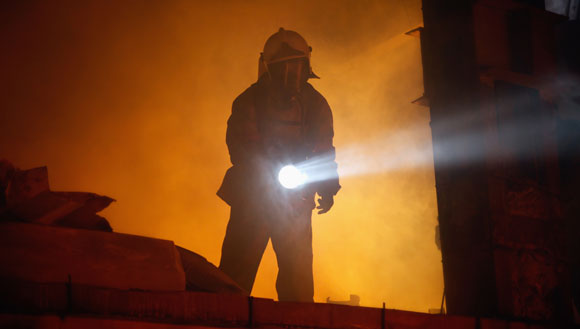
What is spontaneous combustion?
Spontaneous combustion occurs when a material in contact with air can heat up sufficiently (without an outside heat source) to burn. The oils in some wastes and rubbish can slowly react with oxygen in the air. This reaction creates heat that can build up over time if the wastes are left undisturbed. When the heat level in a "self-heating material" is high enough (i.e., when the temperature reaches the autoignition temperature), a fire may start.
For example, rag soaked with vegetable oil in the bottom of a pail could heat up enough to cause spontaneous combustion of the rag. However, the same oil-soaked rag would not be expected to heat up on a clothes line because there would sufficient contact with moving air that would prevent heat from building up. An oil-soaked rag would not heat up if it were in a tight bale because it would not have enough air. Similarly, wet or improperly cured hay stored loose (i.e., not baled) in a barn is susceptible to heating up enough to cause spontaneous combustion. In the cases of spontaneous combustion of hay, grain and oil seeds, the source of heat comes from the action of microorganisms (e.g., bacteria, fungi) on materials having the right moisture and temperature conditions. Damp charcoal, meals (i.e., ground seeds), materials (fabrics, rags, cotton, etc.) soaked with paints containing drying oils are some other examples of materials have a spontaneous combustion hazard.
Why is good ventilation important?
Well-designed and maintained ventilation systems remove flammable vapours from the workplace and reduce the risk of fire and health problems.
The amount and type of ventilation needed to minimize the hazards of flammable and combustible liquid vapours depend on such things as the kind of job, the kind and amount of materials used, and the size and layout of the work area.
An assessment of the specific ways flammable and combustible liquids are stored, handled, used and disposed of is the best way to find out if existing ventilation controls (and other hazard control methods) are adequate.
Some workplaces may need a complete system of hoods and ducts to provide acceptable ventilation. If flammable vapours are likely to condense, the ducts should have welded joints. Other workplaces may only require a single, well-placed exhaust fan. Use non-ferrous fan blades and shrouds (housing), and explosion-proof electrical equipment in ventilation systems for these liquids. Regular cleaning of the ducts, filters, plenums, etc. will decrease the severity of any fires and will reduce the likelihood of spontaneous combustion if some self-heating material is present. Ventilation equipment used to handle solvent vapours should meet the relevant fire code requirements.
If the ventilation keeps vapour levels below the occupational exposure limit of a chemical, usually there is little risk of fire or explosion. Vapour levels harmful to people are, in most cases, much below the lowest concentration of vapour in air that can burn. For example, toluene has a workplace exposure limit of 20 ppm [50 parts of toluene per million parts of air or 0.005 percent] (ACGIH 2008 TLVs & BEIs) in many jurisdictions. This is far below the lower flammable limit (LFL) for toluene, which is 12,000 ppm (1.2 percent).
In baking and drying ovens, enclosed air-drying spaces, ventilation duct work or other enclosures where workers are not normally exposed to the vapour, keep vapour levels to 20 percent or less of the LFL.
How do I store flammable and combustible liquid containers properly?
Store flammable and combustible liquids according to the laws, including building, fire, and electrical codes, that apply to your particular workplace. These laws specify the kinds of storage areas, such as storage rooms and cabinets, allowed for these liquids. They also specify how to construct these storage areas and the amounts of flammable and combustible liquids in different types of containers that you can store in each kind of storage area. There may also be restrictions about the volume (how much) of product that can be stored. For example: in some jurisdictions, containers used to store flammable or combustible liquids that are smaller than 230 litres, must meet the specifications in following regulations (for construction of the container):
- the "Transportation of Dangerous Goods Regulations"
- CSA B376-M "Portable containers for Gasoline and Other Petroleum Fuels"
- CSA-B306 "Portable Fuel Tanks for Marine Use"
- ULC/ORDC30 "Safety Containers"
- Section 6 of CSA-B620 "Highway Tanks and Portable Tanks for the Transportation of Dangerous Goods"
Your local fire code will specify the quantity of liquid that may be stored at the workplace.
Containers of not more than 1 litre capacity used for flammable liquids (5 litres for combustible liquids) are generally exempt.
Ensure that all containers have WHMIS labels attached, where applicable.
Never use plastic or glass containers for storing flammable liquids unless storage in metal containers would affect the required liquid purity or if the liquid would cause excessive corrosion of the metal container.
In all cases, allow only trained, authorized people into storage areas. Before storing, inspect all incoming containers to ensure that they are not damaged and are properly labelled. Do not accept delivery of defective containers.
In general, store containers of flammable and combustible liquids separately, away from process and production areas, and away from other materials. This separation will reduce the spread of any fire to other materials in storage. It will also protect the stored flammable and combustible liquids from exposure to fires in other areas, and accidental contact with incompatible materials.
Keep containers closed when not in use.
Keep the amount of materials in storage as small as possible. It is a good practice to keep no more than one day's supply of flammable and combustible liquids in the immediate work area. Return any leftover material to the proper storeroom or storage cabinet at the end of the day.
What should a good storage area be like?
Store flammable and combustible liquids in areas that are:
- well ventilated to reduce vapour concentrations.
- free of ignition sources.
- cool (temperature controlled) and dry.
- supplied with adequate firefighting and spill clean-up equipment.
- away from elevators, building and room exits, or main aisles leading to exits.
- accessible by firefighters.
- labelled with suitable warning signs. For example: "No Smoking".
Avoid storing flammable and combustible liquids in basements. Ground floor storage is usually preferred as it provides easier access for emergency situations.
Inspect storage areas regularly for any deficiencies such as damaged or leaking containers, poor ventilation or non-approved equipment. Unapproved modifications or damage to approved or explosion-proof equipment or systems could result in unintended hazardous conditions. Correct all deficiencies as soon as possible.
It may be possible to store small amounts of flammable liquids (less than 235 litres or about 62 U.S. gallons) and combustible liquids (less than 470 litres or about 124 U.S. gallons) in approved containers in specially designed storage cabinets near their point of use.
Volatile, flammable liquids are sometimes stored in refrigerators. Use specially designed and approved refrigerators (generally described as "laboratory safe") for this. Standard domestic refrigerators contain many ignition sources and should not be used for storing flammable solvents.
How do I handle drums safely?
Many workplaces receive flammable liquids in large metal drums or barrels, then fill smaller containers from them. Moving full drums weighing hundreds of pounds by hand can be difficult and hazardous. Specially designed drum cradles are available for moving drums around and can also be used as individual drum storage racks.

Why is venting of flammable liquid drums important?
Drums of flammable liquids should have pressure- and vacuum-relief venting installed. Normally, this is done as soon as the drum is opened for dispensing. If a stored drum will be exposed to heat sources or large temperature changes, relief venting may be needed.
Storing a full drum in direct sunlight or near other heat sources can increase vapour levels in the drum. This leads to an increase in pressure that could, in extreme cases, cause the drum to rupture. A buildup in pressure can also result in vapour shooting out into the face or onto the clothing of the person opening the drum. A pressure-relief vent prevents this increase in pressure.
Vacuum-relief vents are also useful. If a drum of flammable liquid is subjected to sudden cooling, a partial vacuum can form inside it. This could, in extreme cases, cause the drum to collapse and leak. Also, for proper dispensing of liquids, the space left behind by the liquid in the drum must be replaced with air so that no vacuum forms. There are different kinds of pressure-relief and vacuum-relief devices, including combination types, available from safety equipment retailers.
What type of containers should I use?
Whenever possible, use approved, properly labelled safety containers when working with flammable and combustible liquids. "Approved" containers are containers that have been approved by testing laboratories acceptable to government enforcement agencies. These laboratories include Underwriters Laboratories of Canada (ULC), Canadian Standards Association (CSA) and Factory Mutual Research (FM). There are many different kinds of approved containers available from safety equipment retailers.
Safety Cans
Portable safety cans for carrying, storing and dispensing flammable and combustible liquids are widely used. They are available in different shapes and in capacities from 0.5 to 25 litres. Approved safety cans are made from metal or very low conductivity plastic. Safety cans have spring-mounted spout caps. These automatically open when the vapour pressure builds up inside, to allow vapours to escape and prevent rupture (or explosion, in the event of fire). The cap-operating mechanisms also cause the spout cap to close automatically when you finish filling or pouring from the safety can, or if the can is dropped.
This safety feature could create a hazard under some conditions. In a warm enclosed space, such as a car trunk, vapours venting from a safety can might reach flammable levels. A spark could cause an explosion. For temporary transport of small amounts (normally less than 25 litres) of flammable liquid, use an approved pressure-resistant and non-venting container. Eliminate ignition sources and ensure good ventilation, too.
Safety cans may also have wire mesh flame arrester screens inside the cap spouts. These prevent flashbacks from reaching the liquid in the cans.
Other Approved Containers
Other types of approved containers include:
- rinse and cleaning tanks for dipping or washing parts in liquid.
- plunger cans for moistening cleaning rags.
- bench cans for dipping and rinsing small parts.
- dispenser or "benzine" cans for dispensing small amounts of liquid directly on work or cloths.
- containers for disposal of flammable and combustible liquids and oily rags and waste.
These approved safety containers also have different kinds of safety devices, such as self-closing lids or flame arresters. Containers like some rinse or dip tanks, or oily rag and waste cans with lids that are not self-closing are held open by fusible link devices. In the event of a fire in an open container, the fusible link melts, closing the lid and smothering the fire.
In certain cases, flammable and combustible liquids may be stored, handled and used in approved, non-reusable glass or plastic containers (usually the ones they are shipped in), holding no more than 1 gallon (U.S.) or 3.8 L. This may be acceptable if the required liquid purity (such as analytical reagent grade or higher) is affected by storage in metal containers, or if the liquid causes excessive corrosion of metal containers.
Why should I inspect the container?
Check all containers used for flammable and combustible liquids regularly to make sure that they are not damaged, that spring-operated mechanisms are working properly and that flame arresters are not broken. Safety container manufacturers will provide detailed ways to inspect their equipment for safe operation.
Why should I label containers?
Properly label all containers used for flammable and combustible liquids. This helps prevent accidentally mixing one chemical with another and reduces the chances of mistaking one liquid for another. Plainly mark the name of the liquid and its hazard on the container. Keep the label clean so that it can be easily seen at all times. Never use a container for any liquid except the one that is marked on the label.
Using unsuitable containers such as jam jars, saucers, open cans, buckets or pails is a dangerous practice. Open containers allow hazardous vapours to escape. Breakable containers increase the chance of serious spills.
How do I dispense flammable and combustible liquids carefully?
Take care when dispensing or transferring flammable and combustible liquids from one container to another. Dispense from only one container at a time. Finish dispensing one material before starting to dispense another. Be sure containers are closed after dispensing to control hazardous vapours and to avoid accidental spills. Approved transfer pumps and drum faucets that cannot be left running accidentally are available. Check these devices periodically to be sure that they work properly and do not leak.
Use an approved safety drip can below each drum faucet to catch spills or drips from worn or damaged faucets.
Never dispense flammable and combustible liquids near ignition sources. Always make sure that metal containers are bonded and grounded when dispensing.
Never transfer liquids by pressurizing their usual shipping containers with air. The pressure may damage ordinary drums and barrels, or create a flammable atmosphere inside the containers.
Mark dispensing areas with suitable warning signs.
How do I dispose of waste material safely?
Store waste flammable and combustible liquids in the same way as unused flammable and combustible liquids. Clean drums made of compatible material can be used to store waste liquids if they are vented, grounded and bonded similarly to dispensing drums. Approved safety disposal cans are also available for waste liquids.
Place cloth, paper and other solid materials that are soaked with flammable and combustible liquids in approved oily waste disposal cans. These are made of metal and have self-closing lids. Do not overfill them, and empty them at least at the end of every workday to reduce the chance of spontaneous combustion.
Clearly label all waste containers with their contents.
Be careful with "empty" flammable and combustible liquid containers. They may contain enough liquid to create an explosion hazard. Only about 14 mL (0.5 fluid ounce) of liquid are needed to give enough vapour to form an explosive atmosphere in a 182-litre (40-gallon) drum. This amount can easily be trapped in a seam or be present as a very thin film on the inner surface of the drum. Do not perform any work (welding, cutting, drilling, soldering) on an "empty" liquid container until all liquid and vapours have been cleaned out. Contact the chemical manufacturer or supplier for the best way to do this.
Never pour waste flammable liquids down sinks or drains. Dispose of them through hazardous waste collection and disposal companies. Dispose of these wastes according to the environmental laws that apply to your jurisdiction. Contact the appropriate environmental officials for advice.
Why is it important to practice good housekeeping and maintain equipment?
Good housekeeping and equipment maintenance are important wherever any chemicals, including flammable and combustible liquids, are used.
- Keep all areas where these liquids are stored, handled or used clear of burnable materials.
- Provide drip trays and empty them often wherever recurring leakages occur.
- Consider using splash guards to enclose machines or processes that eject flammable or combustible liquids.
- Clean up liquid spills immediately.
- Remove any obstructions that prevent containers with lids held open by fusible links from closing fully.
- Make sure that flammable and combustible liquids are not left where they could block or otherwise prevent people from escaping in case of a fire.
Regular equipment inspection and maintenance are important for controlling the hazards of flammable and combustible liquids.
- Ensure maintenance personnel know the hazards of the materials to which they might be exposed.
- Carry out repairs to equipment properly, including special equipment like explosion-proof fittings. Fires and explosions have resulted from the addition of non-approved parts or equipment to approved systems.
- Do not use safety containers that are damaged in any way. If repairs using approved parts cannot restore safety containers to a safe condition, discard the containers once they have been properly cleaned.
When should I wear proper Personal Protective Equipment (PPE)?
You must wear the PPE necessary for the job you are doing.
If other methods, such as engineering controls, are not available or effective in controlling exposure to toxic materials, wear suitable personal protective equipment (PPE).
Choosing the right PPE to wear when doing a particular job is essential. The other hazards of the flammable and combustible liquid may need to be addressed such health toxicity and reactivity. MSDSs should provide general guidance. Selecting PPE for a specific job is best done with the help of someone who knows how to evaluate the hazards of the job and how to select the proper PPE such as the plant safety officer or in consultation with the Joint Health and Safety Committee.
Know and be familiar with the right PPE for emergencies, as well as for normal operations.
What should I do in an emergency?
Be ready to handle emergencies safely. In emergencies like chemical fires and spills, act fast.
- Leave the area at once if you are not trained to handle the problem or if it is clearly beyond your control.
- Alert other people in the area to the emergency.
- Call the fire department immediately.
- Report the problem to the people responsible for handling emergencies where you work.
- Obtain first aid if you have been exposed to harmful chemicals and remove all contaminated clothes. Emergency eyewash stations and safety showers should be present wherever accidental exposure to materials that can damage skin or eyes might occur.
Only specially trained people, equipped with the proper tools and protective equipment, should handle the emergency. Nobody else should go near the area until it is declared safe.
Planning, training and practicing for emergencies are important so that everyone knows what they must do.
The MSDSs for the materials you are using are a good starting point for drawing up an emergency plan. MSDSs have specific sections on fire and explosion hazards including suitable fire extinguishing equipment and methods (using the wrong fire extinguisher or using it incorrectly is dangerous), spill clean-up procedures, and first aid instructions. If the directions in each MSDS section are not clear or seem incomplete, contact the material's manufacturer or supplier for help.
You can obtain help in developing emergency plans from many other sources too. Local fire departments can assist with fire emergency plans and training. Occupational health and safety and environmental enforcement agencies, provincial safety associations, St. John Ambulance, insurance carriers, professional societies in occupational health and safety, labour unions, trade associations, some local colleges and universities, and CCOHS can supply useful information at little or no cost. Specialized private consultants are also available.
What are basic safety practices for flammable and combustible liquids?
Following these basic safe practices will help protect you from the hazards of flammable and combustible liquids:
- Obtain and read the Material Safety Data Sheets (MSDSs) for all of the materials you work with.
- Be aware of all of the hazards (fire/explosion, health, chemical reactivity) of the materials you work with.
- Know which of the materials that you work with are flammable or combustible liquids.
- Eliminate ignition sources (sparks, smoking, flames, hot surfaces) when working with flammable and combustible liquids.
- Use the smallest amount of flammable liquid necessary in the work area.
- Keep storage areas cool and dry.
- Store flammable and combustible liquids away from incompatible materials (e.g., oxidizers).
- Use approved containers for disposal of rags and other work.
- Store, handle and use flammable and combustible liquids in well-ventilated areas.
- Use approved equipment, including labelled safety containers, for flammable and combustible liquids.
- Keep containers closed when not in use.
- Bond and ground metal containers when transferring flammable and combustible liquids.
- Practice good housekeeping and equipment maintenance. Keep area clear of burnable materials.
- Wear the proper personal protective equipment for each of the jobs you do.
- Know how to handle emergencies (fires, spills, personal injury) involving the flammable and combustible liquids you work with.
- Follow the health and safety rules that apply to your job.
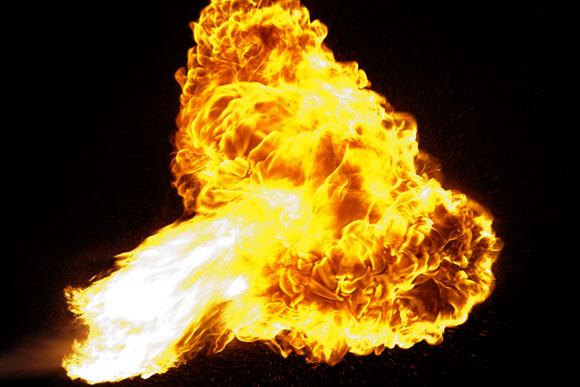
TechnoKontrol Alloy Characteristics
- How it Works
- Physical Characteristics
- Technical Characteristics
- Flammable & Combustible Liquids - Hazards
- What is B.L.E.V.E. Explosion?
- TK-Global Engineering
- TK-Global Electronics
- TK-Global Environment
- TK-Global Technotelecom
- TK-QSSHE
- TK-Financing
- TK-Emergency Call Center
TechnoKontrol product and application videos
- TK Outdoor Tests Presentation - Fire Services / KNPC Kuwait
- Demonstration video
- Liquids balance
- Gas cylinders manufacturation process
- Panel at 1600°C 2 hours
- Wall at 1600°C +2 hours
TechnoKontrol Wikipedia

TechnoKontrol: 1st in Spain for own Technology patents 2013 & 2014

- Ministerio de Industria Turismo y Comercio-OEPM
Technokontrol, the number 1 corporation in Spain filing for its own technology patents, trademarks and utility patents (SPA) - OEPM 2013 The year in numbers (SPA)
TechnoKontrol has been fully verified and certified by Bureau Veritas
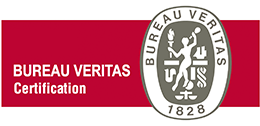
Certificates
- ISO 9001 - ES108784-1
- ISO 14001 - ES108782-1
- ISO 45001 - ES108783-1
- ISO 4126
- ISO 28000
- ISO 37000
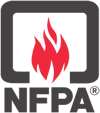
NFPA-National Fire Protection Association
NFPA-Asociación Nacional de Protección contra el fuego
TechnoKontrol is a member of the NFPA
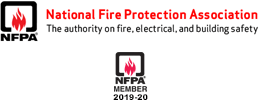
NFPA 69: Standard on Explosion Prevention Systems, 2016 Edition
Prevent deflagration explosions due to combustible dust particles, gases or vapors with NFPA 69. Combustible dust, gases and vapors produced in industrial settings can pose a significant safety hazard.NFPA 69: Standard on Explosion Prevention Systems offers definitive guidance on explosion protection and prevention systems.
ATEX - European Antiexplosive Safety Directives

- ATEX Guide: Protection in explosive atmospheres
- ATEX-EU/HAZLOZ-USA/NFPA-USA/DSEAR-UK/Explosion Directives TechnoKontrol Additional Anti-Explosion Data
- ATEX Directive in EU Directives
Dangerous Substances and Explosive Atmospheres Regulations - United Kingdom/ATEX

United Nations Economic Commission for Europe - UNECE - TechnoKontrol

- TechnoKontrol information for the UNECE BLEVE working group
Proposal transmitted by the governments of Spain and France
The European Parliament and The Council

Technokontrol's Products & Services are insured by

TK-Global Engineering - Where efficiency and reliability become a reality


More info
Should you want to receive more information, please contact us.
